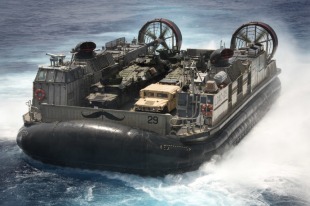Десантні кораблі на повітряній подушці класу LCAC
Основна інформація
Головні розміри
Машина
- 4 * gas turbines
Персонал
Бойові сили та засоби
- Marconi LN-66
- I-band radar
- 2 * 12.7 mm machine guns. Gun mounts can support the M2HB .50 in cal machine gun
- Mk 19 Mod 3 40 mm grenade launcher
- M60 machine gun
- Tests conducted with GAU-13 30 mm gatling gun
The Landing Craft Air Cushion (LCAC) is a class of air-cushion vehicle (hovercraft) used as landing craft by the United States Navy's Assault Craft Units, Japan Maritime Self-Defense Force (JMSDF) and the Republic of Korea Navy. They transport weapons systems, equipment, cargo and personnel of the assault elements of the Marine Air/Ground Task Force both from ship to shore and across the beach.
Concept design of the present day LCAC began in the early 1970s with the full-scale Amphibious Assault Landing Craft (AALC) test vehicle. During the advanced development stage, two prototypes were built.
The first LCAC was delivered to the Navy in 1984 and Initial Operational Capability (IOC) was achieved in 1986. On June 29, 1987, LCAC was granted approval for full production. After an initial 15-craft competitive production contract was awarded to each of two companies, Textron Marine & Land Systems (TMLS) of New Orleans, La, and Avondale Gulfport Marine, TMLS was selected to build the remaining craft. A total of ninety-one LCAC have now been built. The final craft, LCAC 91, was delivered to the U.S. Navy in 2001. Lockheed Shipbuilding Company was competitively selected as a second source.
The LCAC first deployed in 1987 aboard USS Germantown. LCACs are transported in and operate from all the U.S. Navy's amphibious-well deck ships including LHA, LHD, LSD and LPD.
All of the planned 91 craft have been delivered to the Navy. Of these 91 LCACs, seventeen have been disassembled for Government-Furnished Equipment (GFE) or otherwise terminated for cost reasons, two are held for R&D, and 36 are in use on each coast at Little Creek, Virginia and Camp Pendleton, California. Eight minesweeping kits were acquired in 1994–1995. A service-life extension program to extend service life from 20 to 30 years for the remaining 72 active LCACs was begun in 2000 and is scheduled to be completed by 2018.
The craft operates with a crew of five. In addition to beach landing, LCAC provides personnel transport, evacuation support, lane breaching, mine countermeasure operations, and Marine and Special Warfare equipment delivery. The four main engines are all used for lift and all used for main propulsion. The craft can continue to operate, at reduced capability, with two engines inoperable. They are interchangeable for redundancy. A transport model can seat 180 fully equipped troops. Cargo capacity is 1,809 sq ft (168.1 m2). The LCAC is capable of carrying a 60-ton payload (up to 75 tons in an overload condition), including one M-1 Abrams tank, at speeds over 40 knots. Fuel capacity is 5000 gallons. The LCAC uses an average of 1000 gallons per hour. The bow ramp is 28.8 ft (8.8 m) wide while the stern ramp is 15 ft (4.6 m) wide. Noise and dust levels are high with this craft. If disabled the craft is difficult to tow. In recent years spray suppression has been added to the craft's skirt to reduce interference with driver's vision.
The LCAC is a dramatic innovation in modern amphibious warfare technology. It provides the capability to launch amphibious assaults from points over the horizon (OTH) from up to 50 nautical miles (93 km; 58 mi) offshore, thereby decreasing risk to ships and personnel and generating greater uncertainty in the enemy's mind as to the location and timing of an assault, thereby maximizing its prospects of success. The LCAC propulsion system makes it less susceptible to mines than other assault craft or vehicles. Due to its tremendous over-the-beach capability, the LCAC can access more than 80% of the world's coastlines. Previously, landing craft had a top speed of approximately eight knots (15 km/h; 9.2 mph) and could cross only 17% of the world's beach area. Assaults were made from a few miles off-shore. Its high speed complements a joint assault with helicopters, so personnel and equipment can be unloaded beyond the beach in secure landing areas. Now, with LCAC, landing craft complement helos in speed, tactical surprise and without exposing ships to enemy fire.
Six LCAC are in use by the Japan Maritime Self-Defense Force. Approval for the sale was given by the United States Government on 8 April 1994. The craft were built by Textron Marine & Land Systems in New Orleans, Louisiana. Purchase of the first craft was included in the FY93 budget, second in FY95, third and fourth in FY99 and fifth and sixth in FY00.
Two LCAC are in use by the Republic of Korea Navy called as Solgae-class. Build by Hanjin Heavy Industries, to operate from ROKS Dokdo and in future other Dokdo class amphibious assault ships. This project during development that known as the LSF-II or Landing Ship Fast — II. The craft can carry a maximum load of 55 tons, land on hostile beaches doing 40 knots and it can climb at up to 6 degrees. It has 20 mm cannons for self defense. The crew cockpit carry three crew and a landing-force commander.
The LCAC can also carry, in addition to troops, a main battle tank or two amphibious assault vehicles. So far three of these units have been delivered, and more are likely to be ordered. It has been offered for export to foreign navies.
- Коментарі
 uk
uk en
en ru
ru





 Військово-морські сили Республіки Корея
Військово-морські сили Республіки Корея Військово-морські Сили Самооборони Японії
Військово-морські Сили Самооборони Японії Військово-Морські Сили США
Військово-Морські Сили США Textron Inc.
Textron Inc.